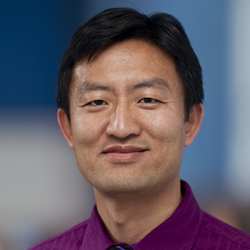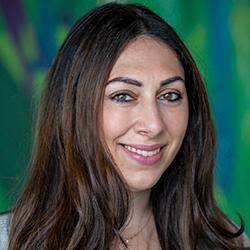Chronic Recurrent Multifocal Osteomyelitis (CRMO) Program
What is CRMO?
Chronic recurrent multifocal osteomyelitis (CRMO) is a disease that causes pain and damage in bones due to inflammation. CRMO is a severe form of chronic nonbacterial osteomyelitis (CNO). It may affect 1 or more bones. Symptoms may come and go for years.
CRMO happens because the immune system attacks the bones and causes inflammation, although there is no infection. In most cases, the cause of the autoimmune response is not known. Very rarely, a genetic change (variant) causes it. CRMO is not fatal.
Why choose Seattle Children’s for CRMO care?
Seattle Children’s has the only program in Washington, Alaska, Idaho and Montana that focuses on children and teens with CRMO. Our expertise means we can correctly diagnose your child sooner, so we can start aggressive treatment to restore bone health.
Thanks to the CRMO Program at Seattle Children’s, a family found answers and treatment for their son’s pain. Now that the symptoms associated with the disease are under control, Seth Maharry is able to focus on doing things he loves most— like playing guitar. Read Seth’s story.
We hold clinics each week in Seattle and Bellevue.
If you would like an appointment, ask your child’s primary care provider or specialist to refer you to our CRMO Clinic. The clinic is part of Seattle Children’s Rheumatology. For information, email us.
If you have a referral, call 206-987-2057 to schedule an appointment.
Providers, see how to refer a patient.
-
Accurate diagnosis to get the right care sooner
- Most doctors have never seen or diagnosed this disease. They may blame your child’s bone pain on growing pains or infection. We care for hundreds of children and teens with CRMO each year.
- Having a dedicated CRMO program means we can see your child within a few weeks of getting your doctor’s complete referral — sooner if there is an urgent need.
- With an early, accurate diagnosis, we can start to rebuild your child’s bone health right away.
- Our multidisciplinary team is very experienced in diagnosing and treating CRMO. Our program brings together experts in rheumatology, bone tumor surgery, infectious disease, musculoskeletal radiology and pathology.
- To provide the best care, your child will have whole-body MRI (magnetic resonance imaging) scans at diagnosis and regular follow-up visits.
-
Expert treatments
- As we treat your child, we combine our deep knowledge of growing children, the latest studies on CRMO and our experience caring for children with this disease.
- We offer a full range of treatments and care for your child based on how severe their CRMO is and what other conditions they have.
- As part of a world-class academic children’s hospital, we have access to experts in many fields of medicine. If needed, we may refer your child to specialists in treating other conditions seen at the same time with CRMO such as doctors that treat bones (orthopedists and physical therapists), skin (dermatologists), the digestive system (gastroenterologists) and pain (pain medicine).
-
Research to improve outcomes
- Because this condition is rare, no single hospital center treats enough patients to answer key research questions often asked by patients and their families. Seattle Children’s partners with other rheumatologists at international children’s hospitals to improve the ways we diagnose, monitor and treat CRMO.
- Yongdong Zhao, director of our program, started the CHOIR registry to share information about the course of the disease and children’s response to treatments. Ongoing studies will help us better understand when children can take less medicine without risking bone damage or a return of symptoms.
- We have also created a biological sample bank, including blood, urine and DNA, to study the potential causes of CRMO and discover disease biomarkers.
- We are able to access data on people with CRMO from across the country (called registries). This helps us learn the best medicines and time frames for children at different ages and severity of the disease. Research is the key to improving care. The U.S. Food and Drug Administration has yet to approve any specific medicines to treat CRMO.
- Dr. Zhao is studying the use of special heat-sensing (infrared) cameras to see if the images generated allow rheumatologists to look at skin temperature to monitor CRMO disease activity.
-
Support for your whole family
- From first visit to follow-up, our team will work with you to provide seamless care.
- We help you fully understand your child’s condition and support you in making the right choices for your child and family.
- Many children with CRMO see doctors often to check how treatment is working and to adjust as needed. To tailor a care plan to your child and to help you know what to expect at every step, we launched our own CRMO Clinic app. This customized web app, built on the Inside Out Care platform, offers information and support about:
- How to manage CRMO at home and at school
- How to prepare your child for an MRI
- How to support your child through different types of treatment
- How to prepare for medical visits
- Tips to avoid extra visits and delays in treatment
- CRMO resources: the latest research findings, support groups and ways to reduce out-of-pocket healthcare costs
- Our program serves children and families from Washington, Alaska, Montana and Idaho. We provide information and resources to help with financial counseling, schooling, housing, transportation, interpreter services and spiritual care. Read about our services for patients and families.
Symptoms of CRMO
- Bone pain is the most common symptom of CRMO. Symptoms may come and go.
- Your child is likely to feel tired when the disease is active. They may avoid using the affected body part.
- In children and teens, CRMO mainly affects the long bones of the legs. But it can involve any part of the skeleton.
- Some people develop joint swelling (arthritis). Less often, symptoms affect the skin, eyes or digestive tract.
- Your child may experience symptoms throughout their lifetime, but CRMO is not fatal.
Diagnosing CRMO
The key to correct diagnosis is ruling out other causes, like infection and cancer. Our CRMO experts have prepared a guide to help your doctor order the tests needed to refer your child to Seattle Children’s for diagnosis and treatment.
- Blood tests look for evidence of inflammation and help doctors rule out other problems.
- A whole-body MRI scan detects all affected bone sites. If the MRI shows that the spine or growth plates are affected, your child may need treatment right away.
- CRMO can sometimes look like cancer or an infection, if those are a concern, we may order a bone biopsy. If the bone sample has bacteria, it can't be CRMO, because CRMO is non-bacterial osteomyelitis.
If we think your child’s CRMO might have a genetic cause, we suggest genetic testing. This is rare.
Treating CRMO
We base your child’s treatment on how severe their CRMO is and which bones it affects. Our goals are to:
- Ease your child’s pain
- Stop the inflammation completely
- Prevent CRMO from coming back
- Prevent growth abnormalities in the arms or legs
- Prevent spinal compression fractures
Many children improve with treatment, but often CRMO comes back after stopping medication. That is why we closely monitor your child. Often treatment lasts months or years. In some people, CRMO is a lifelong disease.
-
Medicines
- Half of children with CRMO respond well to nonsteroidal anti-inflammatory drugs (NSAIDs). We keep a careful watch on liver and kidney health in children who take NSAIDs long term.
- For children who need stronger options, we offer disease-modifying antirheumatic drugs (DMARDs) such as methotrexate, biologic medicines (etanercept, adalimumab, infliximab and golimumab) and bisphosphonates (pamidronate and zoledronic acid).
- Some of these medicines can weaken the immune system, so we keep a close watch for fever and signs of infection.
- Your child will need to take medicine long enough to protect their bones and growth. How long depends on the severity and which bones are affected. For most children, we recommend medicine for 1 to 2 years to prevent flare-ups and problems seen when CRMO is not well treated.
- If your child stops medicine too soon, they may have pain or inflammation in more bones. CRMO may damage the growth plate, which can cause 1 leg to be shorter than the other. Inflammation in the spine can be dangerous if the bone collapses. Not all children experience pain in the spine or in other areas of the body. Poorly treated CRMO can also lead to uncontrolled inflammation, which can lead to poor growth.
-
Careful monitoring
- We use whole-body MRI scans to check if treatment is working to heal active bone lesions and prevent new ones.
- How often we recommend MRIs depends on how well your child’s bones have healed and the likelihood of the inflammation returning.
- Before deciding if it’s safe to stop or reduce medicine, we will use an MRI to look for any areas of inflammation.
- After stopping or reducing medicine, we will use MRI scans to check for signs of inflammation.
-
Care coordination
If needed, we will refer your child to other Seattle Children’s specialists for care, such as:
- Orthopedics
- Dermatology
- Gastroenterology
- Oral surgery
- Infectious disease
- Occupational therapy
- Physical therapy
- Pain management
We also help in these ways:
- Coordinate appointments, such as having whole-body MRI scans and clinic visits on the same day
- Arrange care at infusion clinics in your area if you do not live near Seattle
- Advise on accommodations your child may need at school and provide guidance on returning to physical activities
- Help with insurance approvals
What to Expect
To prepare for your first visit:
- Bring a copy of lab results and a disc with X-rays or MRIs, if these were done at a clinic other than Seattle Children’s.
- Make sure all care decision makers are present, whether the meeting is in person or by phone or video call.
During the visit:
- You will meet our team
- We will review with you the results of past lab tests, clinic visits and imaging studies such as X-rays and MRI scans
- We will ask your child and you about how CRMO affects them
- We will provide you with teaching materials
- Our research team may talk to you about our research projects and ask if you would like your child to participate
Who’s on the team?
Leadership
-
Yongdong Zhao, MD, PhD, RhMSUS
Director of Clinical CRMO Program
-
Co-Director, Clinical CRMO Program
Teams
Contact Us
If you would like an appointment, ask your child’s primary care provider or specialist to refer you to our CRMO Clinic. The clinic is part of Rheumatology. For information, email us.
If you have a referral, call 206-987-2057 to schedule an appointment.
We hold clinics each week in Seattle and Bellevue. At this time, we serve CRMO patients only from Washington, Alaska, Montana and Idaho.
Providers, see how to refer a patient.
Telemedicine at Seattle Children’s
You may be offered a telehealth (virtual) appointment. Learn more.
Related Links
- CRMO Resources for Patients and Families
- Chronic Recurrent Multifocal Osteomyelitis (CRMO) Through the Lens of Patients and Families (video 1:12)
- Seattle Children’s CRMO Family Conference (video 1:24)
Paying for Care
Learn about paying for care at Seattle Children’s, including insurance coverage, billing and financial assistance.
Access Additional Resources
Get resources for patients and families, including information on food, housing, transportation, financial assistance, mental health and more.


Social workers
Beth Struckhoff, MSW, LICSW
Back to Top